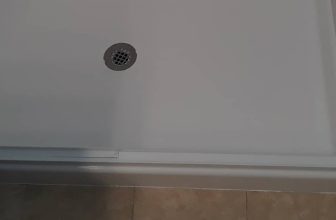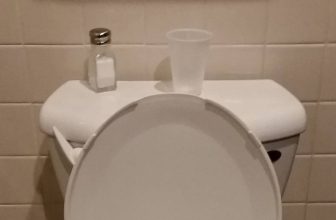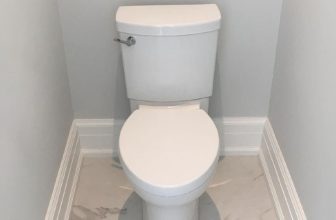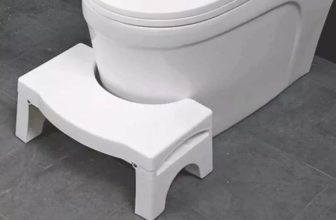1.28 vs 1.6 GPF Toilets: Which to Choose in 2024
While all the residential toilets in the U.S. must comply with the EPA and thus use no more than 1.6 gallons per flush, the newer fashion restricts the flush to 1.28 gallons. It seems reasonable to use less water per flush, but it also raises questions about the reasonable minimum. Will water-saving result in clogs, stains, and finally, in the necessity to spend even more water?
So what’s better: stick with the governmental standards, or pursue the latest trends? Let’s see who wins in the 1.28 vs 1.6 GPF battle and flush the opponent. And this will take some history tour.
Guide
To talk competently about what’s good and what’s bad, we must learn what’s real. Though toilets are items we use daily, there are still myths, legends, and misconceptions circulating about them. It’s time to send the fake conceptions down the drain.
What is GPF?
GPF is short for “gallons per flush” – a logical parameter describing a toilet. It’s defined by the size of the tank: the more water it contains, the more is used to clean the bowl after you’ve done your thing. It’s logical that a larger tank will provide a stronger flush, given the other parameters are the same.
What is GPF in financial terms? Given that the average price of water in the USA is $1.50 for 1000 gallons, and the average person uses the toilet five times a day, and the average family has 3 to 4 members, it gives a considerable economy.
The cost of one flush with a 1.6 toilet is $0.0024 – quite a minor sum, but, given that an average person uses the toilet 5 times a day and 150 times a month, the result is $0.36/mo; for a family, it grows manyfold, and even more, as years pass.
While the effect of replacing your pre-EPA toilet (if you still have one) with an EPA-compliant one can reduce your flush expenses dramatically, installing a 1.28 GPF one instead of a 1.6 GPF reduces it by 20% only. Not a big deal if you use it rarely. But for a big family, it makes sense, especially if you often invite guests.
Why exactly these volumes?
The story started in 1992 when the Energy Policy Act mandated a maximum GPF of 1.6 gallons. In 1994, it became federal law. The volume was based on long-time research considering both water saving on federal level and realistic flushing requirements. All the toilets manufactured in the USA or imported after 1994 should use no more than 1.6 GPF.
This toilet flush rate seems a great economy after the pre-EPA toilets that could use three or even five GPF. Cutting your toilet’s water consumption in two or even in three, though, is not enough.
In 2006, the WaterSense program was introduced, announcing and promoting 1.28 GPF toilets as WaterSense compliant. Its requirements are not obligatory yet, though the EPA (Environmental Protection Agency) supports it on a federal level. By the way, did you know they use soybean paste to test the toilets?
1.28 vs 1.6 GPF: What to Consider?
Now, let’s find the answer: should you settle for a regular EPA-compliant toilet or pursue the WaterSense recommendations? Here are the pros and cons of both options.
1.28 GPF toilets have been said to cause clogging due to weaker flush. Is it true? Probably some models are really weaker, though due to new flushing technologies this is almost no issue now – unless you need an extraordinary flushing power. Then, other things being equal, a 1.6 toilet will suit you better.
Another pro of 1.28 GPF toilets is their money-saving ability. It’s almost neglectable when a toilet is installed in an apartment with only one inhabitant. But the bigger the family and the more frequent guests drop in, the more significant the difference grows.
The price of the toilet effectively does not depend on the flush capacity. There are both expensive, middle-, and economy-class models in either category. It rather depends on the shape, the materials, and the design.
Finally, choosing whether to install a 1.28 or 1.6 GPF toilet, you should consider your health as a reason – namely, how your digestion works. If there is even one member in your family who produces portions bigger than the average, it’s already a reason to choose a 1.6 GPF toilet.
Simply because it may take more than one flush with a big pile, so you will end up using 2.56 GPF instead of 1.6. Hardly it deserves as much concern as Trump once expressed, but still, it’s worth considering.
So what does GPF mean for toilets in terms of the pros of each model? Let’s sum it all up.
1.28 GPF toilets pros:
- Eco-friendly
- Money-saving
- Usually fresher (and thus might last longer)
1.6 GPF toilets pros:
- Better handle bigger waste portions
- Better work with old drainpipes
- More often have partial flush
As for their price, installation, or design, there is no definite winner. Both categories can be cheap or expensive, look beautiful or just functional, consist of one or two units, and be easy or hard to install.
FAQ
There are some questions still being asked about toilets. All of them do deserve a separate answer, even when the answers are implied in the comparison above. Better ask than not know.
What does 1.28 GPF mean in a toilet?
It means that one complete flush (with a full tank) takes 1.28 gallons of water. It’s 20% less than the minimum of 1.6 G set by EPA. Water-saving as it is, it has been the topic of various speculations and rumors.
Does GPF metric always affect flushing efficiency?
No, it does not. It depends on a lot of factors: the volume of waste that’s left, the coverage of the bowl, the condition of drain pipes.
To get you ultimately confused, there is a partial flush feature that can be implemented in both 1.6 and 1.28-GPF toilets. Having it is better than not. But a 1.6-toilet with a dual flush uses just 1.1 G for a partial flush, and if you compare it to a 1.28 model with no dual flush, the larger one may sometimes be just as water-saving.
What flush capacity is best for not clogging?
Rumors may still have it that even toilets with a 1.6-gallon flush may do their job unsatisfactorily, resulting in clogging, let alone 1.28 GPF models. It was true for the first models that hit the market. But now, if you read best no-clogging toilet lists that frequently appear online, they always include 1.28 GPF models. So it depends on a certain toilet rather than on this number.
In addition, you can install a Pressure Assist system, like Flushmate or its likes, that works equally well with 1.6 and 1.28 tanks. It makes your toilet a little noisier, but it greatly improves its flushing ability. No need to plug it, no electricity is needed.
What toilet flush capacity do plumbers recommend?
Today’s 1.28 GPF toilets are already as good as the 1.6 ones. Anyway, it depends on the exact model you choose, its design, bowl coverage, dual flush, and your water system and drainpipes in general. If it does its work worse than you expect, you can equip it with a pressure-assist module. Still, if you are not willing to take risks, you still have a great choice of good old 1.6 GPF models.
Related posts:
- Dual Flush vs Single Flush Toilets
- Round vs. Elongated Toilet
- 1 Piece vs 2 Piece Toilet
- Chair Height vs Standard Height
- Why Does My Toilet Keep Running
- How to Adjust Toilet Float
Things to Consider When Alone
So, if you are deciding which toilet to choose, I insist there is nothing bad about 1.28 GPF toilets nowadays. They do their work efficiently, and they can save you some money – a little per year, a noticeable amount in a decade. Clogging isn’t as much of an issue as it was in the 1990s. So come on, save some water for yourself and for the world if you want to!
It would be great if you share this on your Facebook or Twitter to have a nice toilet talk with friends. Or let’s have it right here, in the comments below. No fans to hit, but a lot to talk about.





